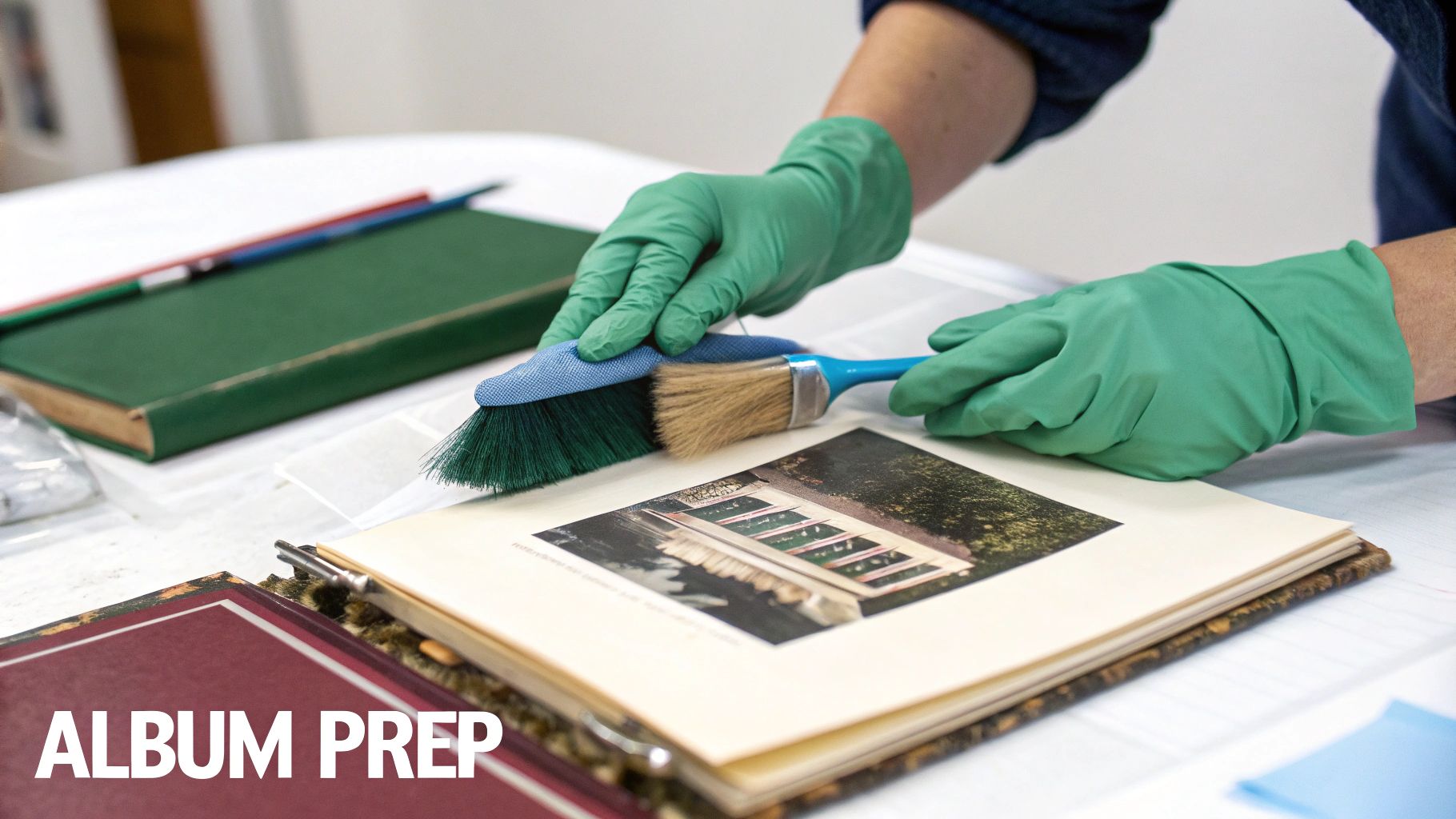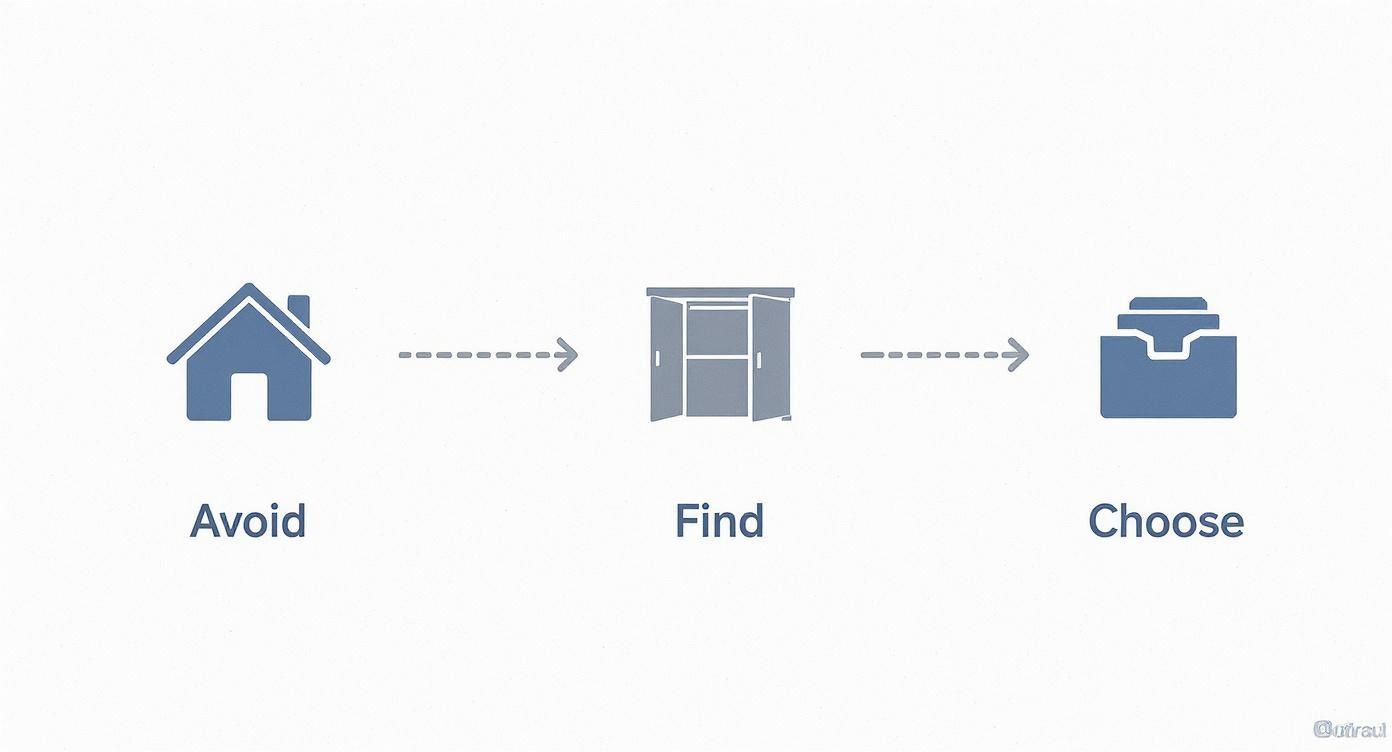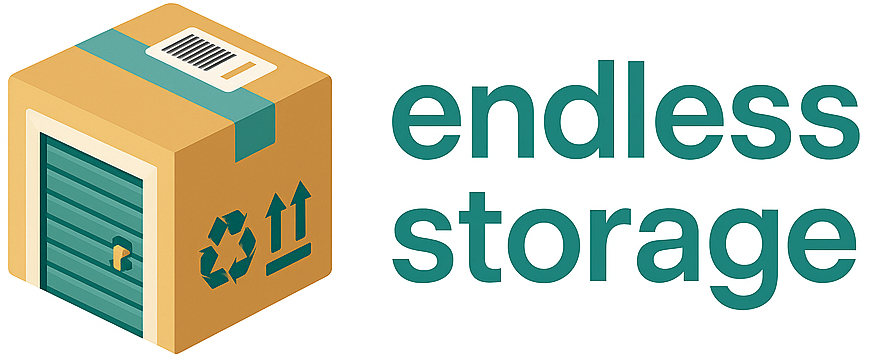To store your photo albums correctly, you need a cool, dark, and dry environment with a steady temperature and humidity level. This simple step is the key to preventing irreversible damage like fading, warping, and discoloration. It ensures those irreplaceable memories are safe for generations to come.
Why Proper Photo Album Storage Matters

Your photo albums are so much more than just books; they are tangible links to your family’s history and personal milestones. Think about that leather-bound wedding album or the slightly worn book filled with childhood photos. These aren't just collections of pictures—they are irreplaceable heirlooms that tell your story.
Unfortunately, many of us unknowingly place these treasures right in harm's way. The most common storage spots, like attics, basements, and garages, are often the most destructive. These areas are notorious for extreme swings in temperature and humidity, creating a hostile environment for delicate paper and photographs.
The Hidden Dangers in Common Storage Spots
Imagine pulling a box from the attic only to find your wedding album's cover has warped from the summer heat. Or discovering that photos from your childhood have developed a yellow tint due to moisture in the basement. These scenarios are all too common.
The primary culprits behind this kind of damage are:
- Humidity: High humidity encourages mold growth and can make photos stick together, while low humidity turns paper brittle and prone to cracking.
- Temperature Swings: Constant expansion and contraction from changing temperatures can stress an album's spine and cause pages to warp.
- Light Exposure: Direct sunlight and even harsh indoor lighting will fade colors and break down the chemical structure of photographs over time.
Protecting your albums isn't just a chore; it’s an essential act of preserving your family's legacy. Each photo is a moment frozen in time, and proper storage ensures those moments can be revisited for years to come.
This commitment to physical keepsakes is stronger than ever. The global market for photobooks and albums hit roughly USD 3.42 billion in 2024, driven by a growing desire for tangible ways to organize memories. You can find more insights on this trend in the photobook market report from Fortune Business Insights. It just goes to show how much people still value having physical copies of their most cherished moments.
Prepping Your Albums for Long-Term Preservation

Before you even think about packing, a little prep work is your best defense against future damage. How you store your photo albums matters, but what you do beforehand can stop preventable decay dead in its tracks. Start by taking a good look at each album one by one in a well-lit area.
You're looking for the common signs of aging. Check for cracked spines, photos slipping out of their corners, or any discoloration on the pages. Older albums, especially those from before the 1980s, often used acidic paper that yellows and gets brittle over time—a real danger to the photos themselves.
Gentle Cleaning and Handling
If the covers are just dusty, a soft, dry microfiber cloth is all you need to gently wipe them down. Steer clear of water or any chemical cleaners. Moisture is the enemy here; it can easily seep into the pages and lead to warping or even mold.
When you’re handling a particularly fragile or vintage album, always support the spine with one hand as you turn the pages with the other. This simple trick prevents putting too much stress on the binding, which is often the first part to give out. If you find loose photos, you’ll have to decide whether to re-secure them or just store them separately. To get the full rundown on handling individual pictures, check out our guide on the best way to store photographs.
Avoiding Damaging Materials
One of the biggest culprits of photo damage I've seen over the years is the old "magnetic" photo album. You know the ones—they use a sticky, acidic adhesive and a plastic overlay that can permanently bond to your photos over time, causing irreversible damage.
If you discover photos trapped in these magnetic albums, your best bet is to carefully remove them. You can then slip a piece of archival-safe, acid-free paper between each photo to keep them from sticking to one another in storage.
It's clear people are valuing high-quality keepsakes more and more. In fact, the market for premium flush mount photo albums was valued at around USD 300 million in 2023. You can dig into more of this data on the high-end album market on DataHorizzon Research. This trend just goes to show why investing a little time now in proper preservation is so incredibly worthwhile.
Finding the Safest Storage Spot in Your Home
Picking where to stash your photo albums is just as important as what you put them in. We all have that go-to spot—the garage, attic, or basement—but for photos, these are the absolute worst places. They’re notorious for wild temperature swings and humidity, which is a recipe for warped covers, mold, and photos getting permanently stuck together.
Think about what a sweltering attic does in August. It can literally make album covers bend and photo pages fuse. On the flip side, a damp basement is a breeding ground for mildew that will stain and ruin your collection for good. The goal is to find a spot inside the main, lived-in part of your house where the climate stays nice and stable.
Identifying Ideal In-Home Locations
The best spots are usually right under your nose. You're looking for anywhere that’s dark, dry, and keeps a comfortable, consistent temperature all year.
- An Interior Closet: A hallway or bedroom closet is perfect. It’s shielded from outside walls, so it doesn't get hit with those drastic temperature changes.
- Under a Bed: The space under a bed in a climate-controlled room is another great option. It’s dark, stable, and keeps albums safe from light and environmental shifts.
Remember, the golden rule for photo album storage is consistency. A stable environment, even if not perfectly calibrated, is far better than one with wild swings between hot, cold, damp, and dry.
Selecting the Right Storage Containers
Once you've scouted the perfect location, you need the right gear. It’s tempting to grab any old plastic bin, but that can be a huge mistake. Standard plastic can trap moisture and even release chemicals over time, causing more harm than good.
What you really want are archival-quality boxes. These are made specifically to be acid-free and lignin-free. Why does that matter? Acid makes paper brittle and yellow, while lignin (a natural polymer in wood) breaks down and releases its own acids. For true, long-term preservation, using materials free of these culprits is a must. If you're looking for some solid options, you can explore the best photo storage solutions to protect your irreplaceable pictures.
Choosing the right container is just one piece of the puzzle. Below is a quick comparison to help you weigh your options based on what you’re storing.
Comparing Common Storage Containers for Photo Albums
This quick comparison will help you choose the best container based on material, protection level, cost, and longevity.
Ultimately, archival-quality boxes are the gold standard for keeping memories safe for generations. They provide the stable, chemical-free environment that photos need to survive.
Understanding the massive impact of temperature and humidity is crucial. To dive deeper, you can learn more about the importance of climate-controlled storage in our detailed guide. This knowledge will help you make the best decisions for how to store photo albums safely.
Packing and Labeling Your Collection Like a Pro
Now that your albums are prepped and you've got your archival-safe boxes, it's time to pack them up. Getting this right is about more than just fitting things in a box; it's the key to preventing long-term damage like spine stress or accidental tears. Think of it as creating a safe little time capsule for your history.
Start by wrapping each album individually in archival tissue paper. This acid-free layer acts as a soft buffer, protecting the covers from getting scuffed up and stopping any residue from transferring between albums. It's a small step, but it makes a huge difference.
Here’s the most important tip I can give you: always lay the albums flat. It's tempting to stand them up like books on a shelf to save space, but that puts a ton of strain on the spine over time. You’ll end up with weakened, cracked bindings. Laying them flat distributes the weight evenly and keeps everything intact.
This simple process flow breaks down how to find the best storage spots in your home.

As the visual shows, the main goal is to avoid volatile environments and choose stable, archival-safe solutions instead.
Creating a Simple Inventory System
Packing carefully is only half the battle. You also need to know what's inside each box without having to tear everything open. Trust me, you'll thank yourself later when you aren't digging through five boxes just to find that one specific album. A simple inventory system can turn a chaotic pile into an organized, easy-to-access archive.
Your labeling system doesn't need to be complicated. A simple spreadsheet or even a dedicated notebook is all it takes to create a searchable catalog of your precious memories. This will save you so much time and effort down the road.
Just give each box a number and make a list of what's inside. Something like this works perfectly:
- Box 1: Family Vacations (1990-1998), Kids' School Photos (1995-2002)
- Box 2: Wedding Album (2005), Honeymoon Scrapbook (2005)
This method makes finding exactly what you're looking for totally effortless. A clear inventory is especially useful if you’re using a service like Endless Storage. You can learn more about making the most of it in our guide to using storage boxes.
With today’s albums becoming more elaborate and valuable, this level of care is more important than ever. The embedded photo album market is projected to hit $3,521.1 million by 2025, which shows just how much we treasure these physical memories. You can discover more insights about the photo album market on Archive Market Research.
When to Consider Professional Storage Solutions
While setting up a safe spot for your photo albums at home is a fantastic start, there are times when it’s just not enough. Let's be honest, knowing how to store photo albums properly sometimes means admitting your house isn't the best place for them.
If you have a huge collection, irreplaceable family heirlooms, or simply don't have a suitable space, a professional service offers serious peace of mind. These facilities provide an environmental consistency that's almost impossible to match at home, using commercial-grade systems to keep temperature and humidity rock-steady. This stops the warping, mold, and brittleness that wreak havoc on photos during seasonal shifts.
What to Look for in a Professional Service
When your collection’s value—whether sentimental or financial—is high, handing it over to the experts is a smart move. For especially precious albums, or even during a move, it’s worth checking out the various storage solutions that professionals offer to find the right fit.
Here’s what you should be looking for to ensure your memories get the best protection:
- True Climate Control: This is much more than just a room with AC. It means the facility actively keeps both temperature and humidity within a very narrow, ideal range for archival materials.
- Robust Security: Don't settle for less than 24/7 video surveillance, secure access controls, and proper fire suppression systems.
- Cleanliness and Pest Control: A top-notch facility should be spotless and have a proactive pest management plan in place.
Using a professional service is the ultimate set-it-and-forget-it solution. It’s an investment in ensuring your family’s visual history is protected by expert-level care for decades to come.
Lots of modern companies have made this whole process incredibly simple, cutting out the usual hassles of self-storage. For instance, services that provide full-service storage will actually mail you archival-quality boxes and take care of all the pickup and transportation. This level of convenience, paired with professional-grade protection, makes it a superior choice for your most cherished memories.
Common Questions About Storing Photo Albums
Even with the best plan, you're bound to run into a few tricky situations when you start packing up your photo albums. Getting these unique cases right is what really ensures your memories stay safe and sound for the long haul. Let's walk through some of the questions that come up most often.
One of the biggest culprits of photo damage? Those old "magnetic" albums from the 70s and 80s. You know the ones—with the sticky, acidic pages and a clear plastic sheet you peel back. That adhesive is a photo's worst enemy and can cause permanent damage over time.
If you have photos in one of these, you should try to carefully remove them. If a photo doesn't lift off easily, whatever you do, don't force it. I've found that sometimes you can slide a piece of dental floss gently under a corner to break the adhesive's grip without tearing the picture.
Should I Digitize My Photos Before Storage?
Absolutely. Taking the time to digitize your collection before putting it into storage is one of the smartest moves you can make. Think of it as an insurance policy for your memories. Creating digital copies gives you a vital backup in case anything unexpected happens to the physical albums.
This doesn't mean you can skip proper physical storage, but it adds an invaluable layer of security.
Plus, once your photos are scanned, organizing them by date or event becomes so much easier. If you're looking for a good system, our guide on how to organize family photos is a great place to start.
A huge mistake I see people make is vacuum-sealing their photo albums in plastic bags. It feels like you're protecting them from moisture, but you're actually trapping any existing humidity inside. This creates a little terrarium that's perfect for mold growth and speeds up chemical decay.
Always give your albums room to breathe. That's why archival-quality boxes are designed the way they are—they allow for air circulation, which helps regulate humidity and prevents the buildup of harmful gases from old plastics and glues. It’s a simple choice, but it will make a world of difference in how your photos look decades from now.
Ready to give your cherished photo albums the professional protection they deserve? Endless Storage makes it easy with climate-controlled facilities and convenient by-the-box service. Get your archival-quality storage kit shipped right to your door. https://www.endless-storage.com
Frequently Asked Questions
Unveiling the Secrets to Effortless Storage
Endless Storage is available nationwide. You pick a plan, tell us where to pickup, and we'll send a UPS van to collect, whichever state you're in.
Your shipping label will be sent to your email within a few minutes, if not instantaneously. It can also be accessed through your customer profile.
Your box will be shipped to one of our climate controlled self storage facilities in our closest self storage facility. Our manager will accept your package, notify you that your box has been received, and securely stored. Only our managers will have access to Endless Storage boxes.
Email us at admin@endless-storage.com click to live chat with us, or send us a message below.
Never! We're committed to transparent pricing with no surprises. You'll lock in your rate with no hidden fees and no long-term contracts.
Fast access guaranteed! Your boxes will arrive at your doorstep within 48 hours of requesting them back. Need to check on delivery? We provide tracking information for complete peace of mind.
Totally flexible! Store month-to-month with no long-term commitment and cancel anytime.
Everything's online! Use your account dashboard to:
• Set up automatic monthly payments
• Request box returns
• Update your address
• Order additional boxes
• Track shipments
Your boxes are insured up to $100 each. Our customer service team will help you file any necessary claims and resolve issues quickly.
Don't worry – we'll email you right away if there's a payment issue. Your items stay safe, though you may have temporary service interruption or late fees until payment is resolved.
When you request our free storage kits, you'll have 30 days to send in your boxes to activate your 3 months of free storage. Think of it like starting a gym membership – your activation window begins when you receive your kits, and your full free trial begins once you send in your first box. During your free months, you'll experience our complete storage service at no cost.
Your 30-day activation window begins when you receive your storage kits. We'll send you an email confirmation when your kits are delivered, marking the start of your activation period.
If you haven't sent any boxes for storage within your 30-day activation window, your free trial will expire and we'll begin charging the regular monthly rate of $9.99 per box. This helps ensure our storage kits go to customers who are ready to use our service.
A box costs $9.99 per month to store (plus sales tax). This price includes free shipping for standard boxes under 50 lbs. and smaller than 16"x16"x16"
Log into your Endless Storage account, locate the box you would like returned, and simply click Return My Box.
Yes, each box stored with us is insured for up to $100 throughout transit as well as the duration of storage within our facilities.
Your box will be at your doorstep within 48 hours of you requesting it back.
Store 10+ boxes? We'll pick them up for free! After your purchase, we'll contact you to schedule a convenient pickup time and arrange UPS collection.
We trust UPS with all shipments, and every box includes $100 insurance coverage. You'll receive tracking information to monitor your items' journey.
Yes! Visit any of our locations by appointment. Just bring a photo ID matching your customer profile.
For everyone's safety, we can't store hazardous materials, firearms, or perishables. All items must fit within our standard boxes.
It's easy! Order your storage kit online, and we'll ship it to you within 1-2 business days. Your shipping labels will be emailed instantly and available in your account.
We're here to help! Email us at admin@endless-storage.com, use our live chat, or send us a message through your account.
To cancel your storage service with Endless Storage, please email your cancellation request to admin@endless-storage.com. Our team will process your request within 2 business days and confirm your cancellation via email.
We understand packing takes time. However, to maintain your free trial benefits, you'll need to send at least one box within the 30-day activation window. If you need more time, you can always start with one box to activate your trial and send the rest later. You can always reach out to admin@endless-storage.com if you have any issues or concerns.
When you request our free storage kits, you're starting a 30-day window to begin using our storage service.
To avoid any charges, simply send at least one box for storage within 30 days to activate your 3-month free trial. If you decide not to use our service and don't send any boxes within the 30-day window, a one-time $50 fee will apply to cover the costs of materials and shipping. This helps ensure our storage kits go to customers who are ready to use our service.
Think of it like reserving a hotel room – we're setting aside space and sending specialized packing materials for your use. The fee only applies if you request materials but don't begin storage, similar to a hotel's no-show charge.

